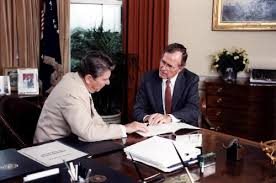 Once upon a time, “cap-and-trade” wasn't an object of conservative Republican opprobrium (e.g., as a “big government cap-and-tax scheme that will destroy our economy and end our way of life as we know it”). Actually, once up on a time, “cap-and-trade” was…wait for it…a conservative Republican idea! That's right, let's head to the “way back machine” and briefly review the Political History of Cap and Trade.
Once upon a time, “cap-and-trade” wasn't an object of conservative Republican opprobrium (e.g., as a “big government cap-and-tax scheme that will destroy our economy and end our way of life as we know it”). Actually, once up on a time, “cap-and-trade” was…wait for it…a conservative Republican idea! That's right, let's head to the “way back machine” and briefly review the Political History of Cap and Trade.
John B. Henry was hiking in Maine's Acadia National Park one August in the 1980s when he first heard his friend C. Boyden Gray talk about cleaning up the environment by letting people buy and sell the right to pollute. Gray, a tall, lanky heir to a tobacco fortune, was then working as a lawyer in the Reagan White House, where environmental ideas were only slightly more popular than godless Communism. “I thought he was smoking dope,” recalls Henry, a Washington, D.C. entrepreneur. But if the system Gray had in mind now looks like a politically acceptable way to slow climate change-an approach being hotly debated in Congress-you could say that it got its start on the global stage on that hike up Acadia's Cadillac Mountain.
People now call that system “cap-and-trade.” But back then the term of art was “emissions trading,” though some people called it “morally bankrupt” or even “a license to kill.” For a strange alliance of free-market Republicans and renegade environmentalists, it represented a novel approach to cleaning up the world-by working with human nature instead of against it.
Despite powerful resistance, these allies got the system adopted as national law in 1990, to control the power-plant pollutants that cause acid rain. With the help of federal bureaucrats willing to violate the cardinal rule of bureaucracy-by surrendering regulatory power to the marketplace-emissions trading would become one of the most spectacular success stories in the history of the green movement…
In the end, the conservative Republican-inspired “cap-and-trade” system for acid-rain-causing sulfur dioxide was put into place by Republican President George HW Bush, who “not only accepted the cap, he overruled his advisers' recommendation of an eight million-ton cut in annual acid rain emissions in favor of the ten million-ton cut advocated by environmentalists.” And it worked incredibly well, “cost[ing] utilities just $3 billion annually, not $25 billion… [and] by cutting acid rain in half, it also generates an estimated $122 billion a year in benefits from avoided death and illness, healthier lakes and forests, and improved visibility on the Eastern Seaboard.”
In short, good things happened when we harnessed the tremendous power of the market to solve environmental problems. Today, the biggest and most pressing of those problems – identified, once again, by a massive amount of scientific research and evidence over several decades – is not acid rain, but global warming. And the proposed solution, once again, is the conservative, market-based “cap-and-trade” system. Strangely, however, it's conservative, market-based Republicans who have morphed into the loudest and most vociferous opponents of “cap-and-trade,” while Democrats have become its biggest proponents.
Even stranger, as Climate Progress points out, many Republicans are now opposing – even “demagoguing” – against an idea they once supported! A short list includes: Sen. Lisa Murkowski (R-AK), who once said she supported cap-and-trade because she believed “it offers the opportunity to reduce carbon, at the least cost to society;” Sen. Scott Brown (R-MA), who once bragged that voting for “cap-and-trade” in Massachusetts was an “important step … towards improving our environment;” Sen. John McCain (R-AZ), who once asserted that cap-and-trade “will send a signal that will be heard and welcomed all across the American economy;” and Sen. Lindsey Graham (R-SC), who used to believe that we should “set emission standards and let the best technology win.” Actually, as Steve Benen at Washington Monthly points out, the McCain-Palin official website in 2008 promised that a McCain administration would “establish…a cap-and-trade system that would reduce greenhouse gas emissions.”
My, how times have changed in less than 2 years.
The point of all this is simple. Cap-and-trade is not some dastardly scheme to destroy the U.S. economy. Cap-and-trade is not radical, either. In fact, cap-and-trade is a tried, true, tested and proven, market-based approach to reducing greenhouse gas emissions at the lowest possible cost. It worked with acid rain, far faster and cheaper than anyone predicted. Why would it be any different with carbon dioxide than sulfur dioxide? And why would Republicans oppose their own idea, after watching it produce one of the biggest environmental victories in U.S. history, on the gravest environmental threat facing our country and our planet? Even more, why would Republicans oppose an idea that — even if you put aside the issue of global warming — is still imperative – for urgent economic (e.g., sending $400 billion overseas every year to pay for imported oil) and national security (sending that $400 billion to a lot of countries that aren't our friends, are building nuclear weapons programs, etc.) reasons?
It's hard to think of any good reasons, how about some bad ones? Because, in the end, that's about all the cap-and-trade naysayers have left.


 Sign up for the Blue Virginia weekly newsletter
Sign up for the Blue Virginia weekly newsletter









